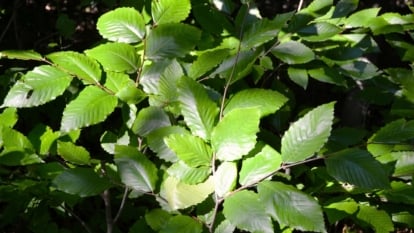Pollinators are vital members of our ecosystem. These insects and animals pollinate one-third of the food we eat and more than 180,000 species of flowering plants worldwide. To support these beneficial insects, consider growing fall pollinator plants to provide them with the nutrients they need before winter.
All humans need pollinators, but for gardeners, these insects are valued employees, paid in nectar and pollen. In winter, most pollinators take part in some degree of hibernation or migration. For this reason, fall-blooming plants are vitally important to pollinators.
It is easy to see the fall garden as a place beginning to close down for its winter hibernation. But don’t give up on your plants just yet; pollinators depend on those fall bloomers to get them through the long migration or hibernation ahead.
Honey bees are not native to the United States, so they do not necessarily depend upon native plants to sustain them. However, native bees, butterflies, and moths all have plants that are important to them for sustenance. Planting these native plants in your pollinator garden will bring an abundance of fall pollinators to your yard.
Amaranth
 The amaranth plant usually blooms in shades of red and pink, typically from summer until the first freeze.
The amaranth plant usually blooms in shades of red and pink, typically from summer until the first freeze.
Amaranth is a group of plants grown for both ornamental purposes and as food crops for humans. This grain is packed with nutrients and protein making it a great food source for us. It is also packed with nectar, making it a valuable food source for bees, butterflies, and hummingbirds.
These interesting plants produce flowers in shades of red and pink, providing nectar for pollinators from summer until the first freeze of fall. Many types of amaranth are native to various parts of the US, with the A. retroflexus species found in all contiguous states and A. spinosus as an indigenous species to most of the eastern and central states.
Anise Hyssop
Used as an herbal remedy, anise hyssop creates a delightful, naturally sweet tea that requires no additives.
This is by far one of the most popular plants in my garden. Anise hyssop has aromatic leaves with a fragrance similar to the anise from which the plant takes its name. It produces spikes of tiny, nectar-filled, blue-violet flowers.
Anise hyssop makes a delicious tea that has a sweetness without any additives. It is a great food source for all kinds of bees, from bumble bees to honey bees, to tiny sweat bees. They are long-blooming perennials, flowering from June until the first frost.
Bee Balm
 From midsummer through fall, bee balm displays lovely flowers and emits a delightful fragrance.
From midsummer through fall, bee balm displays lovely flowers and emits a delightful fragrance.
With a name like bee balm, these plants are certain to see plenty of pollinator activity in the fall garden. Ironically, bees are not the biggest fans of these flowers. Their long, tubular flowers are not accessible to many bees, but butterflies and hummingbirds love bee balm.
Bee Balm has fragrant foliage and pretty flowers that last from midsummer through fall. It is native to most of the eastern US and reliably cold hardy. They also make nice cut flowers, as the buds will continue to open after being cut, and they have a good vase life.
Black-Eyed Susan
 All types of bees are attracted to the large, yellow flowers produced by the vigorous-growing black-eyed Susan.
All types of bees are attracted to the large, yellow flowers produced by the vigorous-growing black-eyed Susan.
I’ve only recently become a black-eyed Susan enthusiast. Now that I have them in my pollinator garden, I can tell you that they are absolutely the most popular plant among native bees. Watching these tiny pollinators working diligently, wearing their bright yellow pollen pants, and gathering sweet nectar from sweet Susan has become a pleasant pastime.
Black-eyed Susan is native to nearly the entire North American continent. It is a vigorous grower producing tons of large, yellow flowers that are major attractors of all types of bees. Their sunny yellow flowers with dark contrasting centers are bullseyes for these pollinating insects.
Blanket Flowers
 This flower is a significant food source for bees and thrives in cooler temperatures.
This flower is a significant food source for bees and thrives in cooler temperatures.
These lovely little plants make a wonderful foreground as they stay low to the ground, which is likely why they have earned the name blanket flowers. They spread out low to the ground, forming a blanket of brightly colored, daisy-like flowers.
Blanket flower prefers cooler temperatures and blooms best in spring and fall. Some varieties are native to all parts of the United States and prefer large expanses of dry, sandy soil where they can spread freely. They are a good food source, primarily for bees, but butterflies won’t turn them down either.
Blue Mistflower
 To prevent blue mistflowers from overpowering other plants in the garden, it is vital to manage their growth.
To prevent blue mistflowers from overpowering other plants in the garden, it is vital to manage their growth.
This plant in the Aster family is popular in my garden with monarch butterflies. Beginning to bloom in May, these flowers continue until late fall, stopping with the first frost. They have a spreading habit and can quickly crowd out other plants in the garden, so it is best to keep them under control or give them space to spread.
The native range for mistflower extends from Canada to the southernmost region of the United States as far west as Texas. It may find its way into your yard uninvited, but it will definitely contribute its role as a provider for pollinating insects.
Bugbane
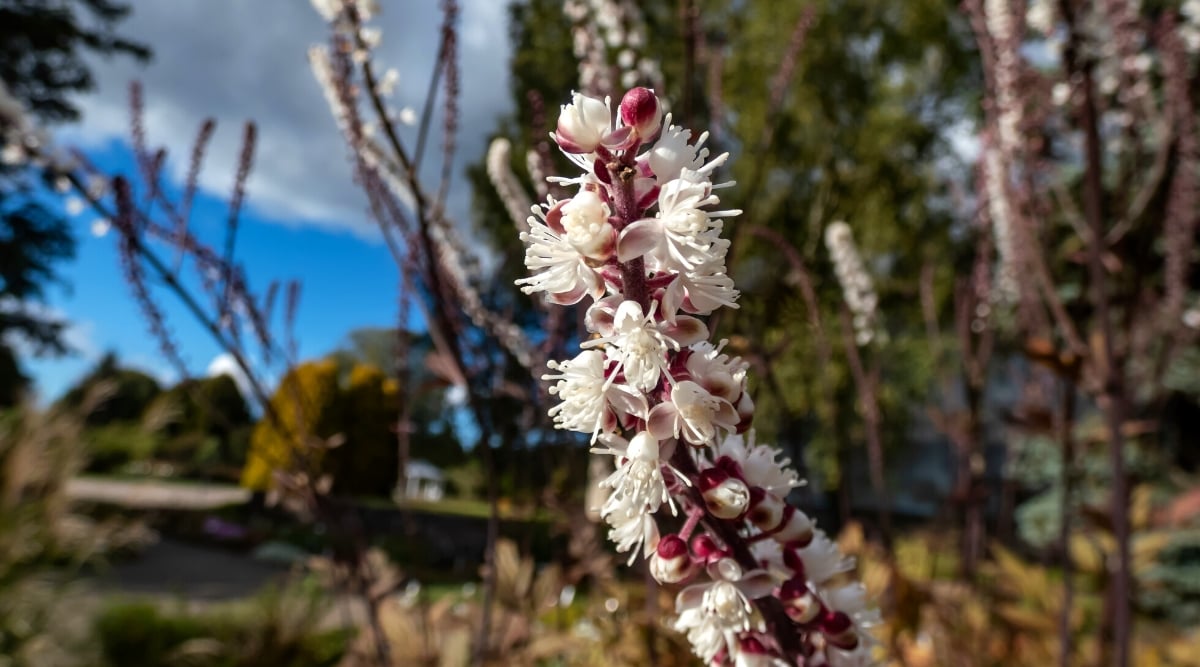 The fragrant flowers of bugbane clusters are shaped like bottle brushes.
The fragrant flowers of bugbane clusters are shaped like bottle brushes.
For a plant with such a funny name, bugbane is an unexpectedly elegant and beautiful native to most of North America. Named for its tendency to repel pests, this plant is actually very attractive to pollinating insects. In late summer and early fall, bees, butterflies, and other pollinators are drawn to the tall spires of white flowers.
Bugbane has very attractive foliage, with large, maple-like leaves and graceful stems that reach up to 6’ tall. The flower clusters are bottle brush shaped, with fragrant flowers that bloom from mid-summer through early fall.
Coneflower
 Coneflowers’ colorful and attractive flowers appeal to various pollinators due to their extended blooming period.
Coneflowers’ colorful and attractive flowers appeal to various pollinators due to their extended blooming period.
Coneflower plants are a great addition to the fall pollinator garden. They have a long blooming period and colorful flowers that are highly attractive to all pollinators. Painted Lady butterflies are especially fond of Echinacea, and the purple variety is a favorite among bees.
While some species can reach up to 4’ tall, some are quite compact, making them a good foreground plant or border. They are sturdy plants, typically in zones 4-9, although a few species are hardier varieties that can grow in zones 3-10. Leave the seedheads attached for finches to eat in cold weather.
Cosmos
 Versatile in nature, cosmos plants display delicate foliage reminiscent of ferns.
Versatile in nature, cosmos plants display delicate foliage reminiscent of ferns.
Cosmos is another flowering plant that is always abuzz in the garden. These versatile plants have delicate, fern-like foliage in shades of pink, orange, yellow, purple, red, and white. A meadow of these southern United States natives can be seen along many a highway, doing their part to maintain populations of native pollinators and honeybees alike.
I am growing the ‘Rubenza’ variety in my fall garden this year and eagerly anticipating the prolific blooming season. The flowers are self-seeding, so they are known to spread throughout the garden like wildflowers!
Garden Phlox
 Most phlox are low maintenance and drought tolerant, growing in tall clumps.
Most phlox are low maintenance and drought tolerant, growing in tall clumps.
Garden phlox are wonderful additions to the pollinator garden. They have a long blooming season beginning in summer and lasting through the fall. With attractive foliage and large clusters of fragrant flowers, they attract many types of butterflies and hummingbirds.
Phlox have tall, sturdy stems, making these excellent cut flowers as well. They grow in tall clumps and are low maintenance and drought tolerant. Plant them in full sun for most flowers, but they will happily tolerate part shade in the afternoon. You can also try out creeping phlox for a pollinator-friendly groundcover.
Goldenrod
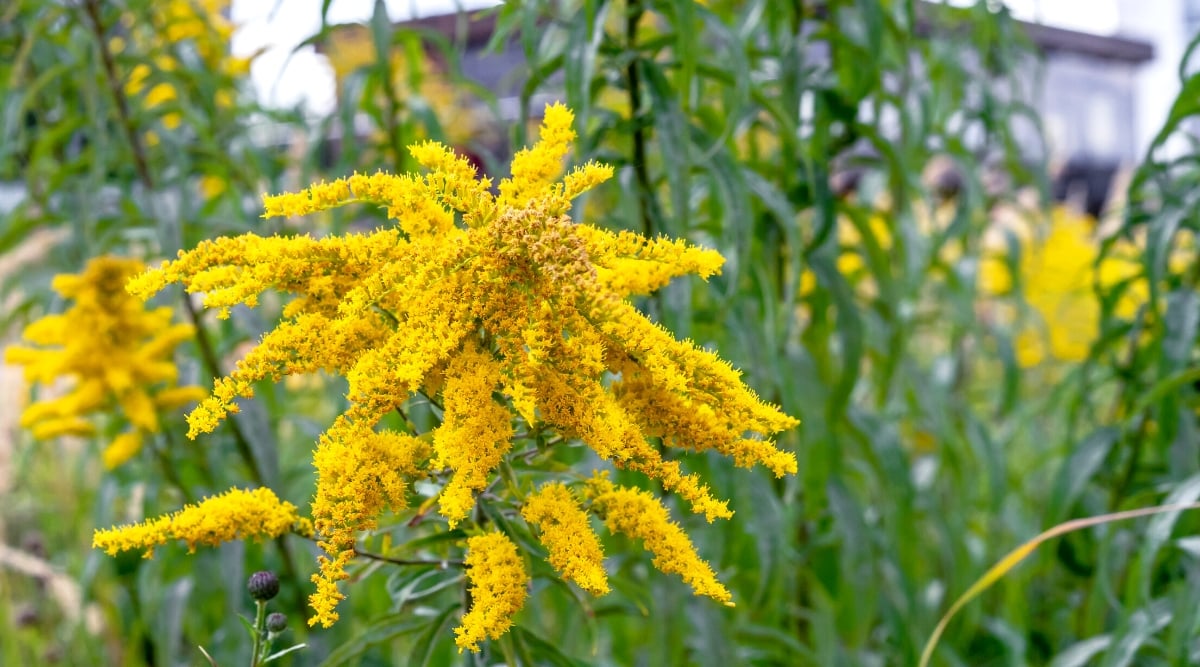 These native plants are spread by seeds and rhizomes, making them fast multipliers.
These native plants are spread by seeds and rhizomes, making them fast multipliers.
Goldenrod plants are a very important fall food source for pollinators all over the United States. Although not native south of the Carolinas, these plants have been naturalized as far south as Florida. The genus contains more than 100 species that range from creeping growth habits to 6’ tall giants.
These plants are spread by seeds and rhizomes, making them fast multipliers. They produce a lot of nectar and pollen in late summer and into the fall months when few other plants bloom at such a rate. They also make nice cut flowers if you’re not allergic to them, which is common (some attribute ragweed as the real culprit for these fall allergies).
Hairy Alumroot
 The foliage of hairy alumroot forms low shield-shaped mounds with attractive, maple-like leaves.
The foliage of hairy alumroot forms low shield-shaped mounds with attractive, maple-like leaves.
Hairy alumroot is a low-growing plant that prefers partial shade or dappled sunlight. It is native to the eastern and central United States, from New York to Georgia. Pleasantly deer-proof, the flowers of this plant bloom in late summer and fall, providing a food source to bees and other pollinating insects.
This plant’s foliage is attractive, with maple-like leaves forming low shield-shaped mounds. Towering a foot or more over the leaves, the flowering stems are topped with clusters of small white flowers. Hairy alumroot looks great in the shade garden in groupings.
Joe Pye Weed
 This is a rapidly growing plant and a prolific nectar producer.
This is a rapidly growing plant and a prolific nectar producer.
A fast-growing native of the Eastern and Central United States, Joe Pye Weed is a big nectar producer. They are very attractive to butterflies such as monarchs, skippers, azures, and tiger swallowtails.
Their fall-blooming, pink, white, or purple flowers are magnets for many types of bees, and their seed heads are a great food source for overwintering birds.
The stems are tall, up to 7’, with bright green foliage. The flowers appear at intervals along the stems nearing the top, and a large cluster tops each stem. These flowers produce dark, fruity-tasting honey when frequented by honeybees.
Little Bluestem
 Several species of skipper butterflies use little bluestem, a popular ornamental grass, as their larval host food.
Several species of skipper butterflies use little bluestem, a popular ornamental grass, as their larval host food.
Little bluestem is a common ornamental grass that also serves as a larval host food for several species of skipper butterflies. It is native to southern Canada and nearly all of the contiguous states. It is highly drought tolerant and prefers to be high and dry in its location and soil.
The flowers of this plant are wind pollinated, so they are not important to bees and other pollinators. However, they do provide larval food for skipper butterflies, making them a great addition to the fall pollinator garden.
Mealycup Sage
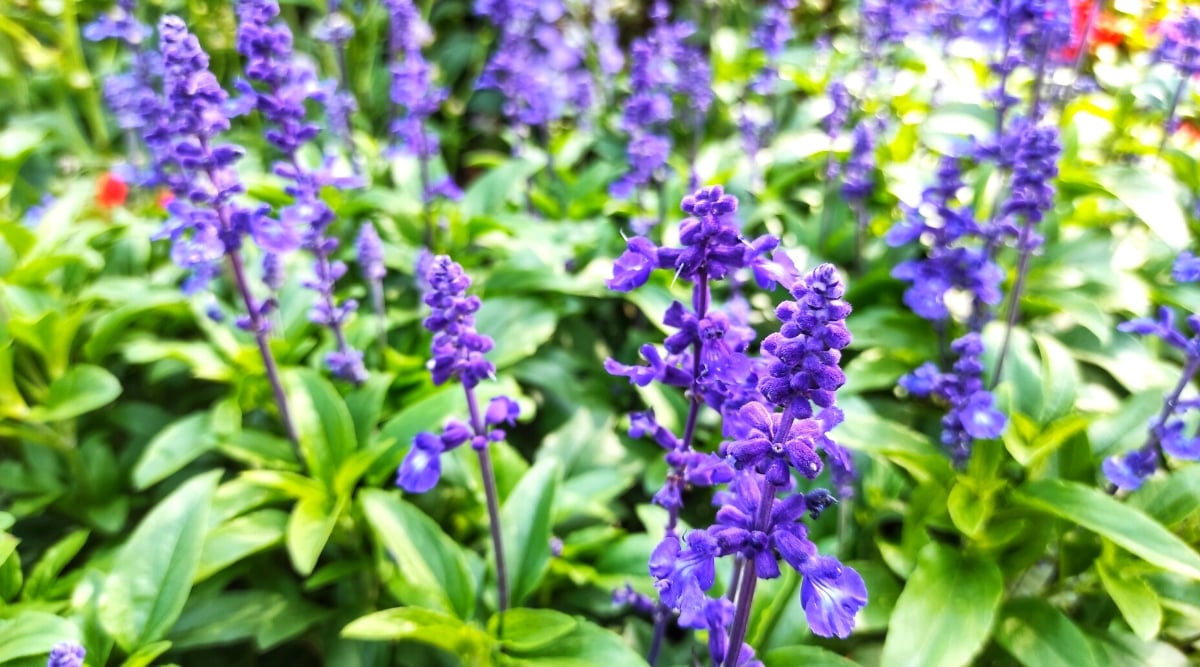 This plant has fragrant foliage and produces blue-violet flowers.
This plant has fragrant foliage and produces blue-violet flowers.
Mealycup sage is a type of salvia which is hugely popular among pollinators. This cultivar is native to central-southern North America, but there are species of Salvia native to nearly every part of the country.
This species has fragrant foliage and produces blue-violet flowers, a bee’s favorite color! The flowers bloom on tall stems from summer until the first frost. Butterflies and hummingbirds also frequent these lightly fragrant flowers, and the seedheads are food for Goldfinches in the winter.
Maximilian Sunflower
 During the fall months, Maximilian sunflowers attract a variety of pollinators.
During the fall months, Maximilian sunflowers attract a variety of pollinators.
Sunflowers are highly valuable plants where humans, animals, and pollinators are concerned. The perennial Maximillian sunflower is no exception. These fast-growing, towering sunflowers produce heaps of bright yellow flowers. It is native to the central United States, growing wild on prairies.
Maximilian Sunflowers bloom throughout the fall months, drawing butterflies, honeybees, and many species of wild bees. The seed heads are edible and can be harvested or left on the plant for overwintering birds and small animals.
New England Aster
 These blossoms offer abundant nectar for various pollinators from August through October.
These blossoms offer abundant nectar for various pollinators from August through October.
This large Aster grows natively throughout the United States, from the Rocky Mountains to the Atlantic Ocean. It tolerates full sun but needs moderate moisture to tolerate very hot weather. The flowers can be shades of purple, lavender, or pink and grow in large clusters.
Blooming from August through October, New England Aster provides an excellent late nectar source for many pollinators. Monarch butterflies frequent it, and it is also the larval host plant for the Gorgone Checkerspot butterfly, the Pearl Crescent, and the Wavy-Lined Emerald moth.
New York Ironweed
 With many petals, New York ironweed exhibits a distinctive Aster fuzzy appearance and a deep purple color.
With many petals, New York ironweed exhibits a distinctive Aster fuzzy appearance and a deep purple color.
Another Aster family member, New York ironweed, is native to most of the eastern United States. It is particularly prevalent in the Carolinas. This flowering perennial is low maintenance, adaptable, and naturalizes easily. It requires a moderate amount of water and grows quite tall, up to 8’ in height, with a spread of about 3’-4’.
In late summer, New York ironweed blooms heavily. The flowers are deep purple with a signature Aster fuzzy appearance to their many petals. It is a great attractor of wildlife, appealing to beetles, butterflies, and bees with its pollen and nectar-rich flowers, and overwintering birds appreciate its seeds.
Prairie Glow Rudbeckia
 With its easy growth and abundant self-seeding, Prairie Glow readily naturalizes.
With its easy growth and abundant self-seeding, Prairie Glow readily naturalizes.
Also known as brown-eyed Susan, this Rudbeckia species is native to much of the eastern and central United States. The bushy plants bloom intensely from midsummer until the first frost, making them a long-blooming pollinator favorite and an ample food source.
Like all types of Rudbeckia, Prairie Glow is easy to grow and reseeds freely, so it naturalizes quickly and will stick around the garden for years to come.
The flowers are similar in shape and size to black-eyed Susan, but rather than pure, sunshine yellow, Prairie Glow features a bold reddish-orange center with yellow only at the tips of the petals. The center of the flower is a deep, rich shade of chocolate brown. It is great for attracting many types of bees and butterflies to the garden.
Purple Prairie Clover
 Native to the central United States and Canada, purple prairie clover thrives in the dry landscapes of prairies.
Native to the central United States and Canada, purple prairie clover thrives in the dry landscapes of prairies.
Clover plants are known for their nitrogen-fixing habit and intense allure to pollinators, especially bees. Purple prairie clover has a long taproot, giving it excellent heat and drought tolerance, and contributes to the fertility of the soil, in addition to being an attractive garden plant.
Purple prairie clover is indigenous to the dry prairie landscapes of the central United States and north into Canada. Its delicate, fern-like foliage is not typical for a clover.
Tall stems fringed with soft leaves are topped with thimble-shaped clusters of bright purple flowers. In addition to providing food for bees, purple prairie clover is a host plant for the Southern Dogface, California Dogface, and Riakirt’s Blue Butterflies, as well as several moth species.
Short Toothed Mountain Mint
 This mountain mint rapidly forms a strong colony through its rhizome propagation.
This mountain mint rapidly forms a strong colony through its rhizome propagation.
Short-toothed mountain mint is another very easy-to-grow, pollinator-attracting member of the mint family, and it is a lovely plant to include in your fall pollinator garden. With a bushy habit and silvery foliage, it is a pretty plant in addition to its usefulness. Native to most of the eastern United States, continuing west to Texas, this is a pollinator treasure.
Short-toothed mountain mint spreads by rhizome, creating a vigorous colony just a few years after planting. It needs neighbors that will stand their ground against its spreading habit and also provide an attractive contrast to its unique foliage. New shoots are easy to pull in the spring. The white flowers appear from late summer into the fall, attracting bees and butterflies.
Sneezeweed
 This flower earned its name due to its previous utilization as a snuff that induced sneezing.
This flower earned its name due to its previous utilization as a snuff that induced sneezing.
Common sneezeweed is native to all 48 contiguous states and most of Canada, giving this plant the largest North American native zone on the list. The 1”-2” flowers resemble other Aster family members, with wedge-shaped petals around a central disk.
Sneezeweed needs moist soil and lots of sunlight. It gets its name from its historical use as a form of snuff that induced sneezing, once thought of as a way to release evil spirits from the body. Now it is understood that all parts of the plant are poisonous in large quantities, although they serve as popular mating grounds for many pollinators.
Steeplebush
 In warmer climates, bright shade is preferable for the steeplebush, although it does enjoy full sun.
In warmer climates, bright shade is preferable for the steeplebush, although it does enjoy full sun.
This deciduous shrub in the rose family likes an abundance of moisture and grows happily in bogs and marshes. A great pollinator plant for anyone with drainage issues, steeplebush is native from Nova Scotia south to Georgia. This plant likes full sun, but bright shade is better in warmer climates.
In midsummer, the plant forms clusters of flowers in shades of pink and purple that last into the fall. Butterflies love steeplebush, and it also looks nice as an ornamental plant. The foliage and flowers are attractive and brightly colored.
Sunflower
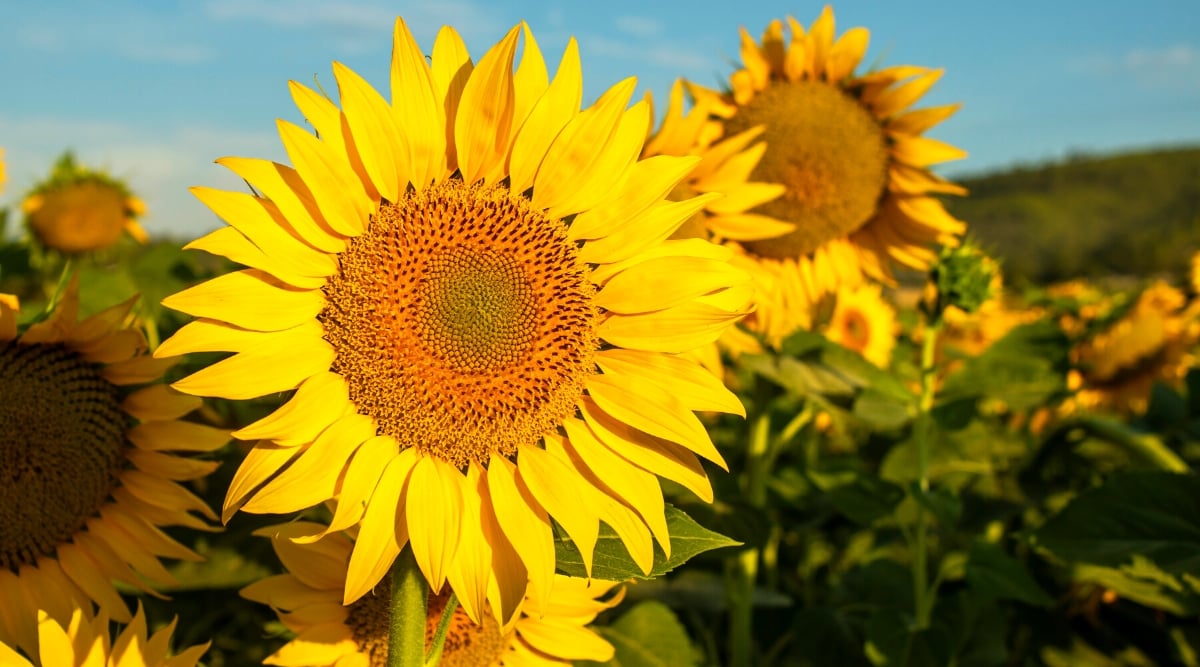 Overwintering birds find sunflowers to be a reliable food source.
Overwintering birds find sunflowers to be a reliable food source.
The common sunflower is one of the most recognizable flowers I can think of. Second, perhaps, only to the rose. Native to nearly all parts of the United States, as well as Europe, it is likely that Sunflowers are the most important plants to keep for the well-being of honeybees, which are native to Europe and Asia. The presence of sunflowers in the range of a bee hive is known to drastically reduce the presence of varroa mites, which are the number one killer of honeybees.
Sunflowers are valuable as a nectar source and a source of pollen, plus a solid food source for overwintering birds. Sunflower seeds can also be prepared in several delicious ways for human consumption.
Swamp Milkweed
 This milkweed is a larval host plant for the monarch butterfly.
This milkweed is a larval host plant for the monarch butterfly.
For most gardeners, the plant that comes to mind when mentioning milkweed is Asclepias fascicularis. It is native to the western half of the United States. Still, it is mainly known for growing from lower Oregon through California and south into Mexico, where Monarch butterflies spend their winter.
This is an ideal food source for Monarchs preparing to migrate back over the gulf in the spring. However, it is not the only native milkweed species in the United States. This brings us to swamp milkweed.
Swamp milkweed is indigenous to most of North America and, like all milkweed species, is an ideal larval host plant for the Monarch butterfly and a valuable nectar plant for other types of butterflies, bumble bees, native bees, wasps, and beetles. In short, this is a plant you need in your pollinator garden. It blooms from spring until the first frost, making it an excellent food source for pollinators almost year-round.
Tickseed
 The flowers bloom in masses from spring through fall, displaying various vibrant colors.
The flowers bloom in masses from spring through fall, displaying various vibrant colors.
Tickseed is very similar in appearance and growth habits to cosmos. Delicate, fernlike foliage creates an attractive textural background for small daisy-like flowers.
Blooms can be yellow, pink, lavender, orange, white, or bi-colored, appearing in masses from spring through fall. This extra-long blooming season makes tickseed an excellent addition to the pollinator garden as it adds interest throughout the year.
Sulfur butterflies frequent this flowering perennial and many different types of native bees. Birds feed on the seedheads, making this a year-round wildlife attractor. Tickseed requires very little care and is drought resistant.
Zinnia
 Both monarch and swallowtail butterflies enjoy the zinnia blooms.
Both monarch and swallowtail butterflies enjoy the zinnia blooms.
We tie up our list with an all-time garden favorite, the zinnia. Zinnias are almost too easy to grow. They can be direct sown throughout the spring and summer, have a relatively short germination time, and bloom from about 60 days after planting until the first frost. Though they are typically annuals, they tend to self-seed, so it is not uncommon for them to return the following year.
In terms of pollinators, zinnias are very attractive to butterflies in particular. Monarch and Swallowtails both favor these blooms, and you might even occasionally catch the occasional hummingbirds hanging around your zinnias.
With many different colors and petal formations, zinnias are a must-have in the pollinator garden for their beauty, usefulness, and diversity. They also make excellent cut flowers!
Final Thoughts
Supporting pollinators in the fall is about more than only feeding insects. Without pollinators, gardening as we know it would be a far less diverse and interesting hobby. Without these vital garden workers, more than a third of what we eat would cease to exist.
Pollinators don’t fret over food in the spring when the garden is booming with a variety of flowering plants, but in the fall, it is even more important to ensure plenty of food for them to make it through the winter. These native pollinator favorites all serve a very important purpose in the garden’s life and the insects it supports.



